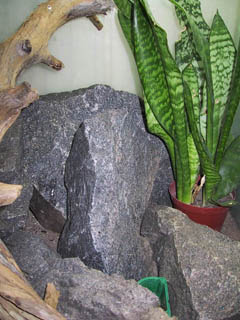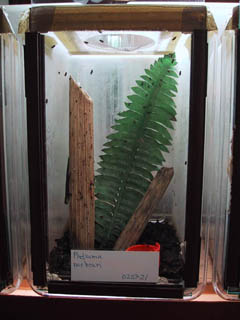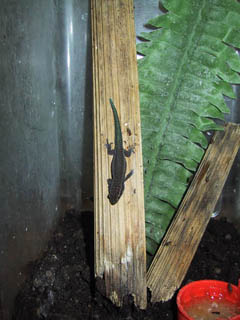 |
|||||||||||||||||||||||||||||||||||||||||||||||||||
|
Terrariet. 2000, Nr.5,(3-12). Daggeckos
av släktet Phelsuma. Terrariet. 2001, Nr.6,(3-9). Phelsuma borbonica gruppen. Terrariet. Bevarandeprojekt. P.klemmeri. IG-Phelsuma. Captive care of Phelsuma rosagularis. IG-Phelsuma. 2002, Nr.41,(21-24). Captive care of Phelsuma barbouri. IG-Phelsuma. Cloosed studbookproject. P.klemmeri. Nordisk Herpetologisk Tidskrift. Daggeckos av släktet Phelsuma. 2002, Nr.5,(130-136). Nordisk Herpetologisk Tidskrift. Phelsuma borbonica. Captive care. Reptilia. 2004, Nr.34,(34-38). Phelsuma mad. boehmei. Reptilia. 2004, Nr.36,(43-47). Phelsuma dubia. Reptilia. 2005, Nr.41,(58-65). Phelsuma borbonica subspecies. Chit Chat. Nr.12,(13-15) Captive care of Phelsuma barbouri.
|
|||||||||||||||||||||||||||||||||||||||||||||||||||
|
Captive
care and maintenance of Phelsuma barbouri |
|||||||||||||||||||||||||||||||||||||||||||||||||||
|
Phelsuma barbouri ( Loveridge 1942 ) origin from the mountains Ambohimirandrana and Mantsina, Madagascar. They only appere on high altitudes up to 2600 meter. The klimat on this altitudes is the main reasoon that this specie are considered a bit difficult to keep and breed in captivity. The average temperature on yearly basis is 13,9° C. The average temperature the coldest month is 10,2°C, and the hottest month 16,1°C. The yearly rainfall is around 1700 mm. Normally the days are hot and dry and the nights cool and moist. On these altitudes sunshine and UV radiation is very intensive, and this together with the almost allways windy conditions makes important parameters for a successful captive care of this specie. |
|||||||||||||||||||||||||||||||||||||||||||||||||||
|
|
|
||||||||||||||||||||||||||||||||||||||||||||||||||
|
and
are reduced to 10 hours between november and february. The halogen spot
are turns on at 11 and goes of at 14 the whole year. This gives the
animales a chance to bask and digest food better even under the cold
winter months. |
|||||||||||||||||||||||||||||||||||||||||||||||||||
|
|
|||||||||||||||||||||||||||||||||||||||||||||||||||
|
|
|||||||||||||||||||||||||||||||||||||||||||||||||||
|
Phelsuma
barbouri |
|||||||||||||||||||||||||||||||||||||||||||||||||||
|
|||||||||||||||||||||||||||||||||||||||||||||||||||
|
|
|||||||||||||||||||||||||||||||||||||||||||||||||||
|
|
|
||||||||||||||||||||||||||||||||||||||||||||||||||
|
|
|||||||||||||||||||||||||||||||||||||||||||||||||||
|
|
|||||||||||||||||||||||||||||||||||||||||||||||||||
|
Captive
care and maintenance of Phelsuma klemmeri
|
|||||||||||||||||||||||||||||||||||||||||||||||||||
|
The specie origin from only three small lokalitys in Northwestern Madagascar.All three are near the coast at altitudes between 25-150 meters.It is mostly living on Bambu,but can be found also on other trees.Just right to P.klemmeri also P.mad.grandis,P.abbotti checkei and P.seippi can be found.From the area the followin klimatedatas was recorded(Sick 1979):Average yearly rainfall 2232 mm,Average temperature 25.7 deg.C,season variation 3.9 deg.C.The dry period is July to August and the rainseason from November to mars. |
|||||||||||||||||||||||||||||||||||||||||||||||||||
|
A suitable terrarium for a pair or a group of adult animales (1.2-4) should be at least 30x30x50.(LxWxH).To provide the animales with natural light,both regarding amount of light and the quality of light,tubes with an Ra of over 90 and 6500 kelvin should be used.There are a lot of different tubes like Reptisun,Vitalight,Iguana light and similar.Important is the abouve ratings and UV B output from the tubes.Of course they should be put over the ventilation and not abouve glass.This it to provide the animales with UV B that can not pass the glass.Since this is a rainforrest specie no other heatsourses then the tubes should be used(exept for very large vivaria).Ideal for the abouve terrarium is two tubes.As substate the top two are pottingsoil and barkmulch.No artificial substrates should be used,like papertowels, newspaper and similar.The reason for this is that these small and flat animales very easily dehydrate, kept under those premisses.Ideal temperatures are during the day 28-29 deg.C ,that is allowed to drop to 21-22 deg.C at night.The humidity should stay between 70-85 %.With daily misting and the abouve guidelines this is easily maintained.A diverse of plants are suitable for this kind of terrarium,but Orchides and Bromelidaes are prefered.The bromelides gives the animales somewhere to find water and suitable egglayingplaces.All live plants of course helps to keep humidity at a stable level.Very important in any Phelsuma terrarium are a lot of vertical and a few horisontal Bambutubes.These serves a lot of purposes.They gives the animales ability to establish territorys,provide them with hidingplaces and good egglayingspots.If a hole is cut in one or a few of the vertical ones this will be the prefered place to lay eggs.This makes it easy to look for eggs without disturbing the animales to much.One or two Bambutubes should also be set horisontal very close (5-10 cm) to the ceiling to provide the animales with a good basking place.Getting this close to the lighttubes will also give them sufficient amount of UV B. |
|||||||||||||||||||||||||||||||||||||||||||||||||||
|
|
|||||||||||||||||||||||||||||||||||||||||||||||||||
|
|
|||||||||||||||||||||||||||||||||||||||||||||||||||
|
Ljus
och värme för terrarier En fråga som ofta dyker upp när terrarieintresserade människor träffas är hur man ordnar en ”bra” belysning av terrariet och dess innevånare. Man pratar om alla typer av lampor och lysrör som idag översvämmar marknaden. Man diskuterar vad som är bäst till vad, men ofta utan att veta vad man igentligen är ute efter. Tänkte med den här lilla artikeln försöka förklara vad ljus är och hur det påverkar våra herptiler. I första hand så inriktar jag mig på ödlor och deras ljusbehov, men självklart så gäller mycket av detta även för andra herptiler. Vad är ljus? Allt ljus är strålning av olika våglängder. Vissa våglängder ger synligt ljus och andra ger osynlig värmestrålning.Det synliga ljuset ligger mellan 390-700 nm. Det som ofta diskuteras i reptilkretsar är Uv strålning och då främst Uvb strålning (gör det möjligt för djuret att tillverka vitamin D3, som är nödvändig för kalkupptaget), men även andra aspekter är nog så viktiga för våra kära husdjur. De bitar som är intressanta är bla: ljusstyrkan som mäts i lux, färgtemperaturen som mäts i kelvingrader och färgåtergivningen ”CRI värdet”. Dessa komponenter i kombination gör att våra terrarieinnevånare kommer att trivas och bete sig på ett naturligt sätt. Självklart så måste man först tänka på hur det djur man tänkt hysa i terrariet lever i sitt naturliga habitat. Djur som lever i trädtoppar har ett större ljusbehov än arter som lever på regnskogsgolvet. En art som är dagaktiv och lever i skuggan av vegetationen blir stressad av för mycket ljus, precis som en som lever i trädtopparna inte fattar att det är dag om belysningen är för svag. Arter som lever i öppen terräng på höga höjder är mer ljuskrävande och utsätts också för högre Uv strålning. Att efterlikna solljuset till 100% i ett terrarium är helt omöjligt med dagens teknik, men man bör göra så gott det går. I full solexponering i tropiska miljöer kan man mäta upp 100000 lux. Färgtemperaturen på ljuset ligger på 6500 kelvin°. CRI värdet ligger på sitt max: 100. För att ge ett exempel med ett terrarium så kan ni fundera på följande värden gällande ljusstyrkan....Vi utgår från ett terrarium som mäter 60X30X30 (längd,bredd,höjd). Det finns inget ventilationsnät monterat ännu, ingen inredning som kan bromsa ljusflödet. På terrariet placerar vi en lysrörsarmatur med ett lysrör på 20W av standardtyp för terrarier. Mäter vi sedan ljusstyrkan på olika nivåer av terrariet ser det ut som följer. 0,8 cm från lysröret: 48200 lux 15 cm från lysröret: 7500 lux 30 cm från lysröret: 2850 lux
Av dessa siffror är det lätt att förstå problematiken med att ge tillräckligt med ljus. Även om vi skulle montera en starkare lampa eller så många lysrör som vi fick plats med så skulle vi inte kunna motsvara ljuset från solen. Dessutom skulle vi grilla både växter och djur pga. värmeinstrålningen. Problemet blir ännu tydligare när ventilationsnätet, och all inredning kommer på plats och ytterligare bromsar ljusinsläppet. Ytterligare en sak som är mycket viktig är att man inte placerar ljuskällan över glaset på taket av terrariet. Man tappar då all UV instrålning eftersom den reflekteras mot glaset. Placera alltid armaturen med UVlysröret över ventilationsnätet . Tänk bara på att lägga en distans mellan armaturen och terrariet. Annars blockerar du ventilationen. Använder man flera ljuskällor, som värmespottar, keramivärmare, grislampor mm, så tänk på att för en många reptiler (framför allt ödlor) är ljus det samma som värme. Placerar du värmespottarna långt från UV röret så kommer de att söka sig till spottarna, då de ger mest ljus, och kommer då inte tillräckligt nära UV källan för att kunna tillgodogöra sig den nödvändiga UVB strålningen. Färgtemperaturen på lysröret anges i kelvingrader och bör ligga på 6500°K, vilket motsvarar naturligt ljus. Färgtemperaturen förstår man lättast om man jämför tex. ljuset från en glödlampa som ger ett gulaktigt sken (2500°K). Beroende på vilka våglängder som ingår i spektrat på röret får man olika färgtemperaturer. Vissa våglängder ger gult, grönt, rött, blått ljus osv. Det flesta lysrör som säljs idag ämnade för reptiler ger ett naturligt ljus, plus UVB och UVA våglängder, men i vissa fall kan man luras. Tex. så finns det idag ett populärt och mycket bra rör som heter ”X”. Det finns i 2.0 till 8.0 vilket avser mängden UVB röret ger. Vad många inte tänker på är att det är helt skilda rör. Man kan tro att det bara är mängden UV som varierar, men så är inte fallet. ”X” 2.0 är ett rör som ger både ”ljus” och UV. Det kan alltså användas som kombinerad ljuskälla och UV källa. De andra rören med samma namn men med högre UV strålning saknar mycket av det synliga ljuset och är rena UV rör som måste kombineras med en annan ljuskälla. CRI-värdet eller färgåtergivningen kan enklast beskrivas som följande. Det är det som gör att ett belyst föremål som är grönt eller rött ser grönt eller rött ut. Det är särskilt viktigt för många ödlor, som har färger som komunikationsmedel. Signaler som parningsvillighet, aggression mm. kan annars misstolkas. I fullt solljus är Ra-värdet 100, men i de flesta bra lysrör når det upp till 98. Även här är detta värde oftast rätt på de lysrör som sälj för reptiler, men det finns givetvis undantag, så fråga för säkerhets skull. UV-strålning delas in i tre grupper enligt följande: UVA- långvågig strålning mellan 320-400 nm. Gynnar signal och reproduktionsbeteenden hos reptiler. UVB- mellanvågig strålning mellan 290-320 nm. Viktigaste typen för reptiler. Tillverkning av vit. D3. UVC- kortvågig strålning mellan 180-290 nm. Skadligt för alla levande organismer. Den ultravioletta strålningens intensitet mäts i mikrowatt per kvadratcentimeter (mW/cm2), och varierar från polerna till ekvatorn. Uvstrålningen en klar dag vid ekvatorn ligger på 270 mW/cm2. Givetvis så varierar detta på grund av en mängd olika faktorer. Detta gäller såväl Uv-strålningen som ljuset i övrigt. Bland dessa faktorer kan nämnas följande: Höjd över
havet: Magnus Forsberg |
|||||||||||||||||||||||||||||||||||||||||||||||||||
|
|
|||||||||||||||||||||||||||||||||||||||||||||||||||
|
Copyright © 2002-2008. Magnus Forsberg Sweden. |
|||||||||||||||||||||||||||||||||||||||||||||||||||


